How Many Species of Storks Are There?
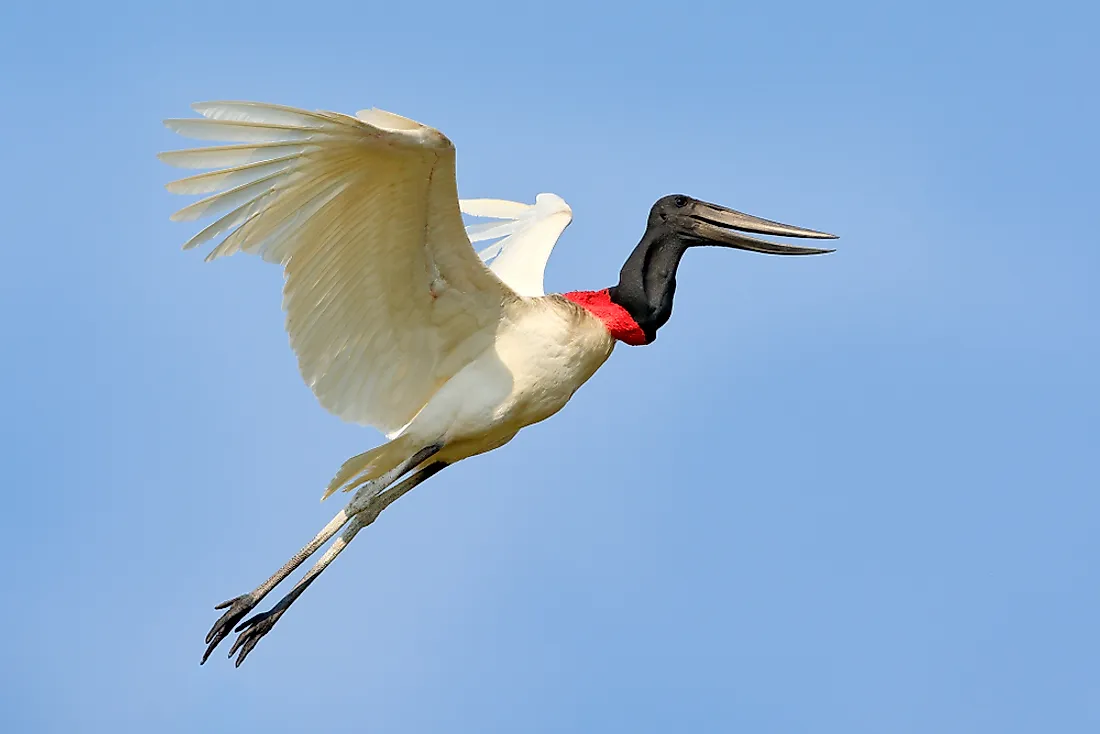
Stock are large wading birds with long legs, necks, and stout bills. They can be found in dry and wet areas although they prefer drier habitats compared to ibises, spoonbills, and herons they also lack the powder down present in the latter. Stocks feed insects, small amphibians, fish, and small mammals. There are nineteen known species of storks.
19. Milky Stork
The milky stork (Mycteria cinerea) is a medium-sized bird that inhabits the coastal mangroves of southeastern Asia. An adult milky stock is white except for the back feathers of the tail and wings. They have a wingspan of between 435–500 mm and a head to tail length of 170 mm.
18. Yellow-billed Stork
The yellow-billed stork (Mycteria ibis) is found south of the Sahara and in Madagascar. It is about 35–41 inches tall. The stock has a white body with a black tail, its bill is yellow and decurved at the end. Its feathers extend to the neck and head behind the eyes while a red skin covers the face and the forehead.
17. Painted Stork
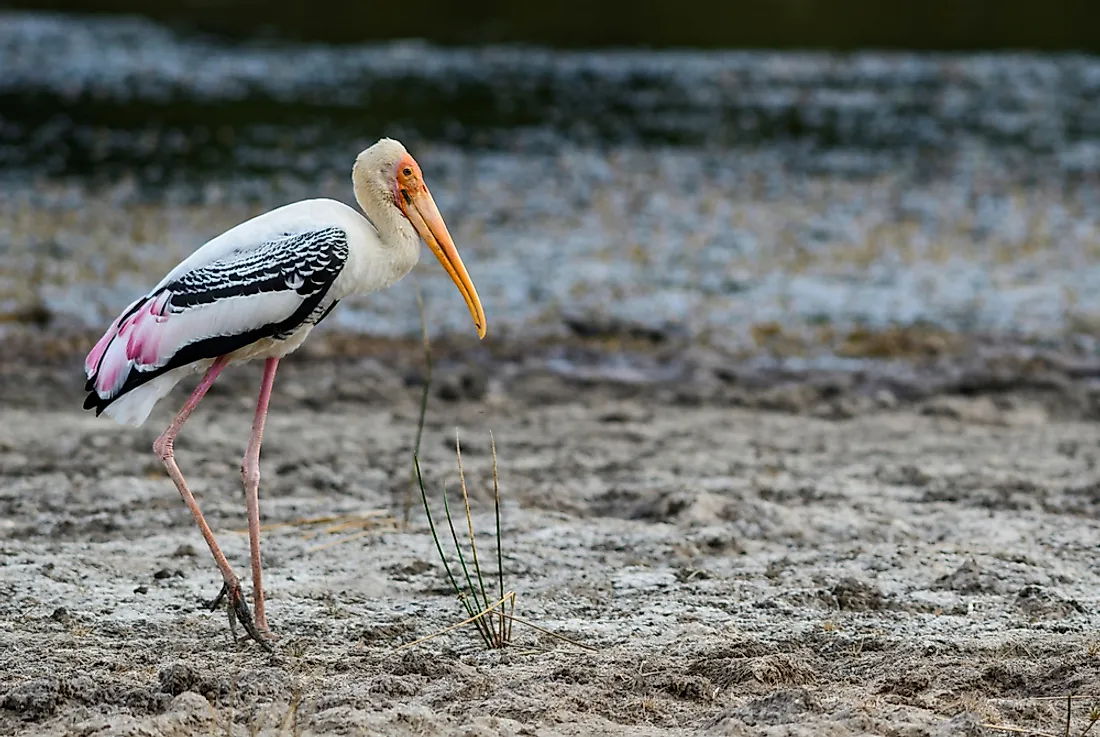
The painted stock (Mycteria leucocephala) inhabits the wetlands of tropical Asia. Its range extends from south Himalayas to Southeast Asia. It acquired its name from the pink tertial feathers found in adults. An adult stock has a white body and a red/orange head. A black breast band with white scaly markings extends along the underwing. The painted stock source its food in shallow waters and lakes.
16. Wood Stork
The wood stork (Mycteria americana) is found in the tropical or subtropical region of America and the Caribbean. It is resident to South America but those in North America are known to migrate to the south. Its plumage is white but the tail and part of the wing feathers are black. The young have a yellow bill while adults have a black bill.
15. Asian Openbill
The Asian openbill (Anastomus oscitans) inhabits parts of Southeast Asia and the Indian Subcontinent. The stock is white or greyish with black wings and tail. The adults have a gap between the lower and upper mandible unlike the young. They forage inland wetlands especially swamps but avoid rivers and lakes.
14. African Openbill
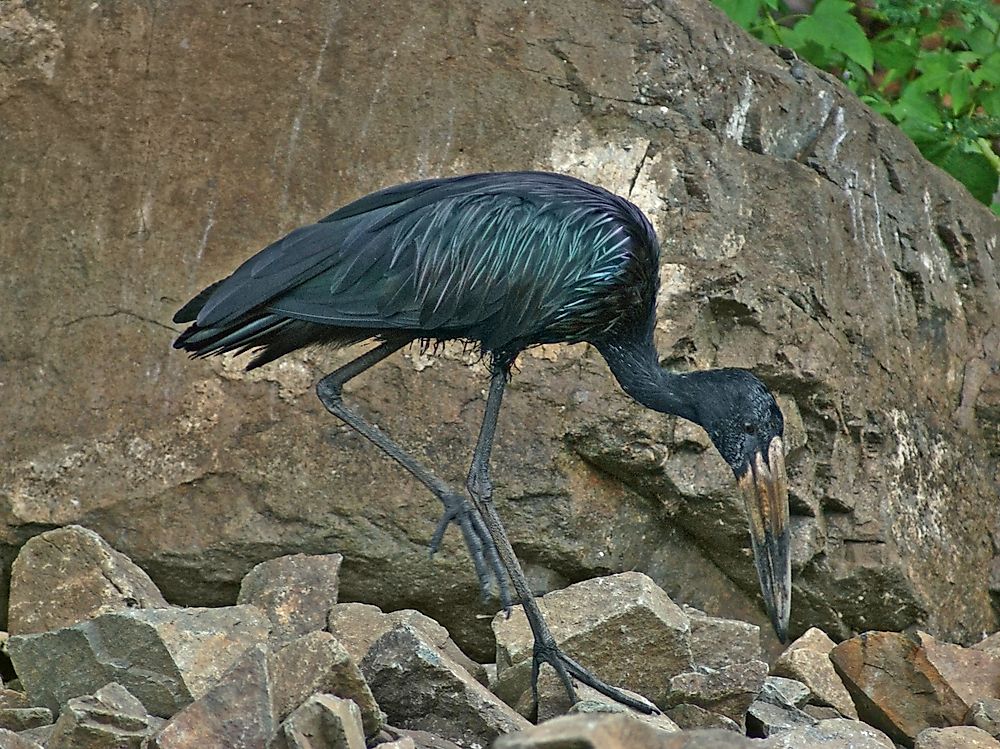
The African openbill (Anastomus lamelligerus) inhabits the sub-Saharan region of Africa from Senegal to Ethiopia and South Africa. The adult’s plumage is dark with glossy brown, green and purple on the breasts. Its bill is large and brownish. The African openbill prefers wetlands where they forage for small amphibians, fish, and mollusks.
13. Abdim's Stork
The Abdim’s stork (Ciconia abdimii) is found in eastern Africa all the way to South Africa. It is a black stork with white underparts, grey bill and legs, and red feet and knees. The front of the eyes is covered by a red facial skin that turns blue near the bill during the mating season. The Abdim’s stork is the smallest of the stock species. They feed on locust, caterpillar, mice, crabs, eggs, and small reptiles.
12. Woolly-necked Stork
The wooly-necked stork (Ciconia episcopus) inhabits the Asian region between India and Indonesia, and parts of tropical Africa. The stock is a resident of freshwater wetlands. It has a glistening black body with a white neck, underbelly, and undertail. They are mainly found in swamps, agricultural land, irrigation canals, and rivers.
11. Storm's Stork
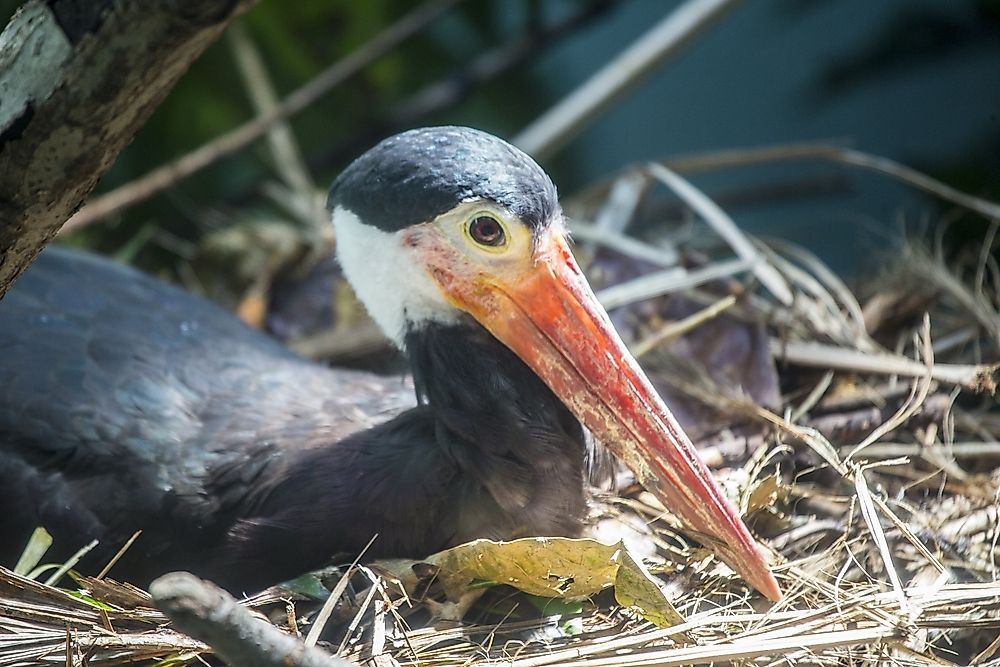
The Storm’s stock (Ciconia stormi) is found in tropical forests of southern Thailand, Malaysia, and Indonesia. It is considered the most vulnerable of storks with a population of less than 500. The stork has a black plumage with a white and black neck. Its facial skin is orange with yellow rings around the eyes. Its bill is pinkish-red.
10. Maguari Stork
The maguari stork (Ciconia maguari) inhabits the wetlands of South America. It resembles the white stork but slightly bigger. The adult plumage is primarily white with black flight feathers and a forked blacked tail. The forked tail distinguishes the white stork from the maguari. Due to its large size, this stock makes three or more jumps before takeoff.
9. Oriental Stork
The oriental stork (Ciconia boyciana) has a close resemblance to the European white stork. The large white bird has black wings that span for about 7.3ft. A red skin circles its eyes, unlike the European white stork. They once roamed across Japan, China, Korea, and Russia but they are no longer found in the Korean peninsula and Japan. The birds migrate between Russia and China.
8. White Stork
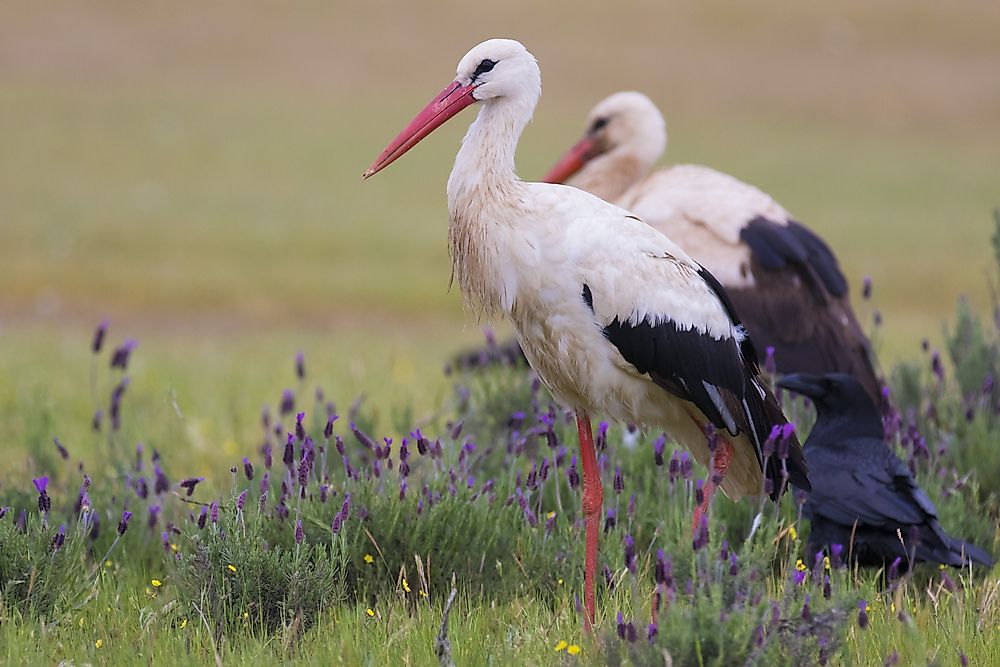
The white stock (Ciconia ciconia) is found across Asia, Africa and much of eastern and central Europe. Twenty-five percent of the world's population is found in Poland and part of western Asia. It is a large bird with a wingspan of up to 45 inches. It has long legs neck and a pointed beak. The plumage is white while the flight feathers are black.
7. Black Stork
The black stock (Ciconia nigra) is found in Europe especially in eastern and central parts of Spain, and the Pacific coastline of Asia. They European flock is known to migrate to Africa. Adults have a length of between 37-39 inches. They have black plumage with white underparts, a red beak, and long red legs. They prefer wetlands where they feed on mollusks, small fish, reptiles, and crawling insects.
6. Black-necked Stork
The black-necked stork (Ephippiorhynchus asiaticus) is a resident of Southeast Asia and the Indian continent. A small disjunct population can be found in Australia. It prefers the wetlands especially in regions with rice and wheat plantation where they hunt small amphibians, reptiles, and insect. The black-necked stork have large heavy bills. Their backs are white and glossy while their heads and necks are bluish-black
5. Saddle-billed Stork
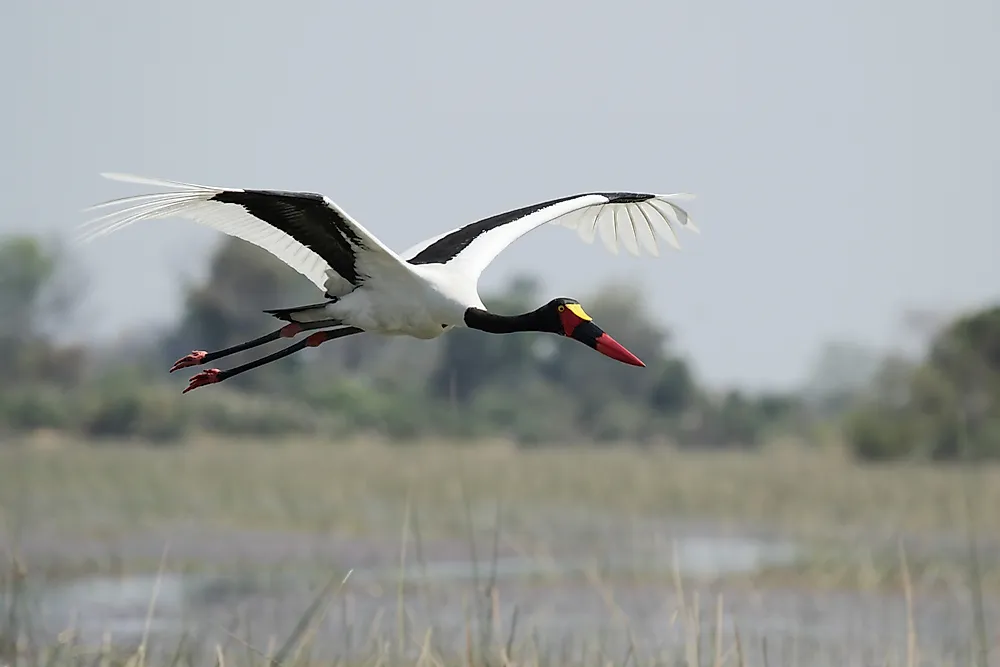
The saddle-billed stork (Ephippiorhynchus senegalensis) inhabits East, South, and West Africa. It is a large bird with a wingspan of up to 8.9 ft and is considered the tallest of the stock species. It has a red long bill that measures between 10.7 to 14.2 inches. Its plumage is white with the exception of the wings, tail, neck, and head. They feed on crabs, frogs, fish, and small reptiles and birds.
4. Jabiru
The Jabiru (Jabiru mycteria) is common in parts of Brazil, Paraguay, Mexico, and Argentina. It is the tallest flying bird of Central and Southern America. The males are predominantly larger and can weigh 25% more than females and stand at 5ft. Their beaks can measure up o 13.8 inches. Their plumage is white except for the head which is featherless and the black neck.
3. Lesser Adjutant
The lesser adjutant (Leptoptilos javanicus) is found in parts of Asia ranging from India, Southeast Asia to Java. it is a solitary bird that prefers wetlands. It is a fairly large bird with a bare neck and head. It closely resembles the greater adjutant but it is slightly smaller and has a pointed bill. Its upper plumage is dark while the underbelly and undertail are white.
2. Greater Adjutant
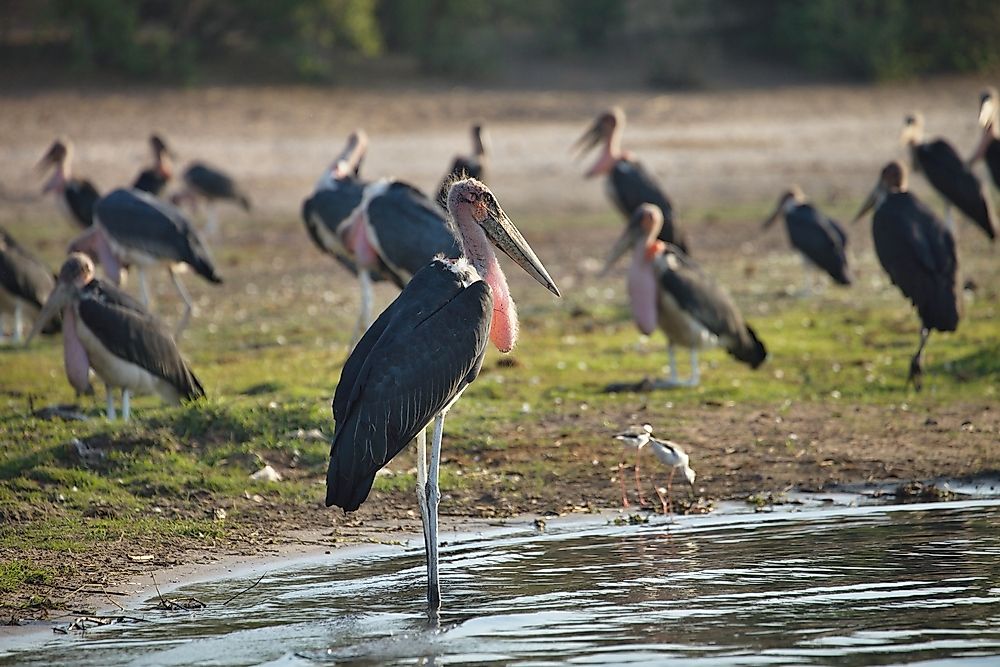
The greater adjutant (Leptoptilos dubius) once roamed across the Asian continent but today they are confined to India and Cambodia. These birds flock together during the breeding season and disperse after. Their bills are massive and wedge-shaped, their heads are bare, and have a neck pouch. Adults have dark wings and white underside. They scavenge alongside vultures, unlike the lesser adjutant that prefer hunting in wetlands.
1. Marabou Stork
The marabou stork (Leptoptilos crumeniferus) inhabits the sub-Saharan region of Africa. It can be found in wet and dry areas near human settlements. It is a huge bird that can weigh up to 20 pounds. The males are slightly larger than the females. The bird is easily identifiable due to its bare neck and head and black back. Its bill is huge while its legs are black.











